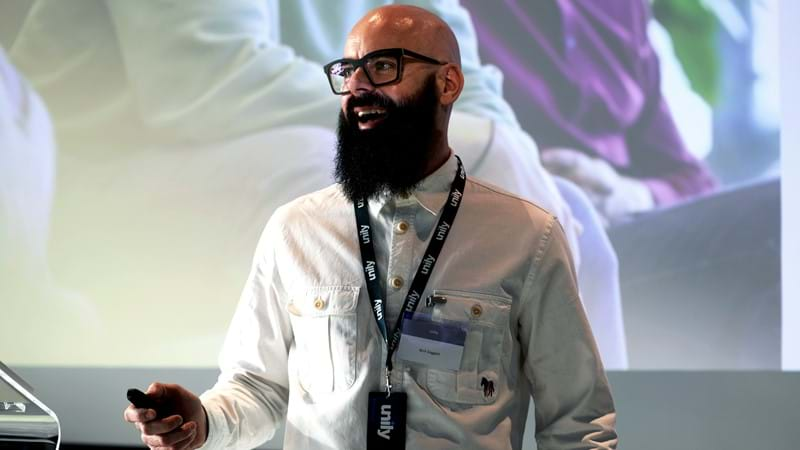5 ways to enhance employee experience in 2021
As the pendulum of the pandemic begins to swing back to some form of normality, organizations need to be looking at how to enhance the employee experience for their workforce in the post-COVID return to work. How can you evolve your employees’ workplace experience in 2021 and ensure you’re set up for the new world of work?

The state of employee experience today
Employee experience was sent on a rollercoaster ride when the COVID-19 pandemic took hold, as enterprises scrambled to navigate new ways of (primarily remote) working and were forced to focus on a digital-first strategy. While 2020 was a year like no other and has been called out as being overwhelmingly negative, employee engagement actually increased 13% compared to the previous year. Organizations have been moving towards putting employees front and center, in the knowledge that a more engaged workforce leads to improved productivity.
The changes brought about last year have impacted employees in different ways – some have been struggling, while others have been thriving. Research from McKinsey showed that remote working has had a positive effect on daily work and levels of engagement, highlighting the importance of giving employees flexibility to work in a manner that suits them.
However, the less positive effects of this new way of work were apparent in stats that showed 41% of US employees were feeling burnt out during the pandemic lockdowns of 2020. Negative emotions, concentration and lack of motivation were all daily struggles, and the expectation going forwards was for HR teams to primarily focus on employee experience.
Roadblocks for delivering strong EX
Because 2020 brought about so much change to the ways we work, the challenges facing HR directors have also shifted accordingly. With huge amounts of people now working remotely, and this looks set to be the norm going forwards, HRDs are now figuring out how to deliver a great, consistent employee experience when the workplace is anything but.
With an increasingly hybrid workforce, new challenges arise. 45% of HRDs think that maintaining consistency is the priority, but creating a strong company culture and working environment is another key challenge. Technological challenges are also becoming a focus, with the need to deliver a digital and physical employee experience simultaneously becoming essential.
Employee experience is more important than ever
In the past, companies have focused on office-based perks to try and improve employee experience – free lunches, nap pods, dog-friendly offices, slides etc. Some were better received than others, but with around $4.9m being spent on employee wellness programs last year, there’s no doubt that EX was being taken extremely seriously.
In the new world of work, enterprises are having to come up with alternatives to in-office benefits. With the shift to remote working, the type of perks on offer are moving away from physical ones and more towards experiential benefits such as employee assistance programs or learning initiatives.
Overcoming the demands of the new world
Good employee experience will help overcome a variety of challenges in the modern workplace, particularly with a digital-first approach. The issues that previously plagued employees have been replaced. Flexibility of working hours and location had often been a pain point for office-based teams and a more agile approach was slowly rolling out across the globe. The pandemic accelerated this agility, effectively removing inflexibility as an issue for a lot of employees. Instead of wanting to have greater autonomy over their hours and location, employees suddenly faced a new set of challenges brought about by remote working.
Frontline teams have long highlighted feelings of isolation and loneliness, particularly from company HQs, and bridging that disconnect has been at the top of the list for organizations for some time. But with the shift of office-based workers to a remote set-up, those emotions are now being felt across the wider workforce. Having a greater understanding of the common pain points, and empathy with these workers, only makes it easier to find ways of solving those problems within the workplace.
As EY put it, HR departments and employees have very different views of employee experience. If you want to achieve long-term success, then closing the gap is imperative. Employees want to feel listened to – they are the ones who can tell you what they want and need to be happy at work, and ensure maximum output and productivity.
Employee experience in the new world of work
As we come out of the pandemic, into what almost feels like a whole new world of work, offering a good employee experience is more vital than ever. As economies recover and recruitment picks up, organizations will be pushed into creating desirable workplaces if they want to capture and retain the best talent.
The digital workplace is going to become a must-have and businesses that have been delaying digital transformation projects may find themselves on the back foot. Remote work is set to be the norm, with offices becoming secondary, so employees will expect to have the tools they need to work from wherever they are in the world. The focus will shift to concentrate on employee safety and wellbeing, with organizations having to address the conditions employees need to work effectively from home indefinitely.
Leaders will be enlisted to help promote a collaborative culture across remote teams and, with frontlines also facing a restructuring of their traditional ways of working, open listening sessions will be needed to keep on top of general feeling. Creating a great employee experience for all your employees will largely come down to implementing digital-based solutions.
5 ways to enhance employee experience
So much has changed in the workplace since the pandemic, and the things that enterprises are focusing on to enhance employee experience have had to shift accordingly. As we come out of the other side of COVID-19 and into the new world of work, a lot of what had previously been a priority has simply been replaced with alternatives. The nature of your business and the type of culture you have in your organization will impact what methods you choose to employ, but here are our top 5 ways to enhance the employee experience.
#1. Put employee wellbeing first
The rise of remote working has cast the spotlight on wellbeing for employees. With an increasingly isolated workforce, employee experience can no longer be enhanced through things like taking your dog to work days; not least because the dog is now with you every day anyway! However, some of those in-person initiatives can be carried over to a remote workforce.
Things like yoga classes or financial wellbeing seminars can now be done online, with recordings hosted on your intranet platform. Although it seems almost counter-intuitive, taking a holistic approach to employee experience can result in a strong ROI. After all, if you’re fostering a culture of caring, you’ll see 4x the revenue growth compared to companies with weak company culture. Help your employees to take care of their wellbeing, so they’re less likely to have time off sick, be more engaged, and produce better work as a result.

#2. Level up your flexible working policies
According to Forrester, 53% of employees want to work from home more often, even after the pandemic, and they predict a higher rate of full-time remote employees in the future. Flexible working is nothing new, but there are some organizations who still haven’t fully embraced this, only implementing a temporary remote working model when COVID-19 hit.
In the aftermath of the pandemic, flexibility is becoming more than a short-term fix or perk, and instead is being seen as an essential component of the overall employee experience. Give your employees more choice and ownership of their schedules to show that you trust them. Explore compact 4-day weeks or hybrid location models that help to meet the needs of your people and give them a better overall work-life balance.
#3. Make diversity and inclusion a priority
A positive employee experience is underpinned by a diverse and inclusive workplace. If your organization is diverse, you’ll see improvements in business performance, innovation, and profitability. 2020 shone a light on diversity and inclusion, with various global movements highlighting the importance of it. Commit to supporting underrepresented groups within your organization and create a strong D&I strategy.
Consider creating a Chief D&I Officer role and put into practice the targets you’ve previously committed to hitting. Highlight diversity and inclusion as key pillars of your company values and culture, and have open conversations with your employees to make them aware that your enterprise is committed to D&I.
#4. Focus on experiential benefits
While it’s easy to focus on the ‘standard’ benefits of paid time off, sick pay, or retirement schemes, don’t let the experiential benefits fall by the wayside. If you don’t already have one in place, consider launching an Employee Assistance Program, where your people can get additional help and emotional support.
The reasons employees stay with a company are shifting away from higher compensation and towards things like the opportunity to grow professionally. Career development, a sense of belonging, and meaningful work are the key factors influencing employee commitment. Give your employees the tools they want – and need – to do their jobs better than ever before. Implement consumer-grade technology internally through an employee experience platform and watch as the efficiency levels rise.
#5. Listen first, act later
Listening and taking no action actually leads to worse engagement than if you didn’t listen at all. Be prepared to implement new strategies off the back of employee comments and your overall employee experience will improve. Increase the amount of passive listening you’re doing and use your intranet platform to do it. Continue to run feedback loops but focus more of your attention on the voices posting on your EXP. Your employees will share comments about their internal priorities – and their personal ones – through social channels, highlighting areas that can be changed or improved.
Once you’ve gathered these comments and voices, you need to ensure you put your plans for change into action. Communicate new initiatives with your organization to help your people thrive. It shows you’ve been listening and will contribute to higher levels of engagement, as well as a more open, collaborative culture within the enterprise.

Upgrade employee experience in the new world of work
According to Jacob Morgan, author of Employee Experience Advantage, employee experience is affected by cultural, technological, and physical environments. As HRDs, the focus needs to be on implementing the processes and tools that make up every stage of the employee journey, from onboarding to exit. If you're interested in enhancing your employee experience, contact one of our workplace experts today.
Get started. Get your personalized demo.
Reinvent your intranet for the employee experience era.















